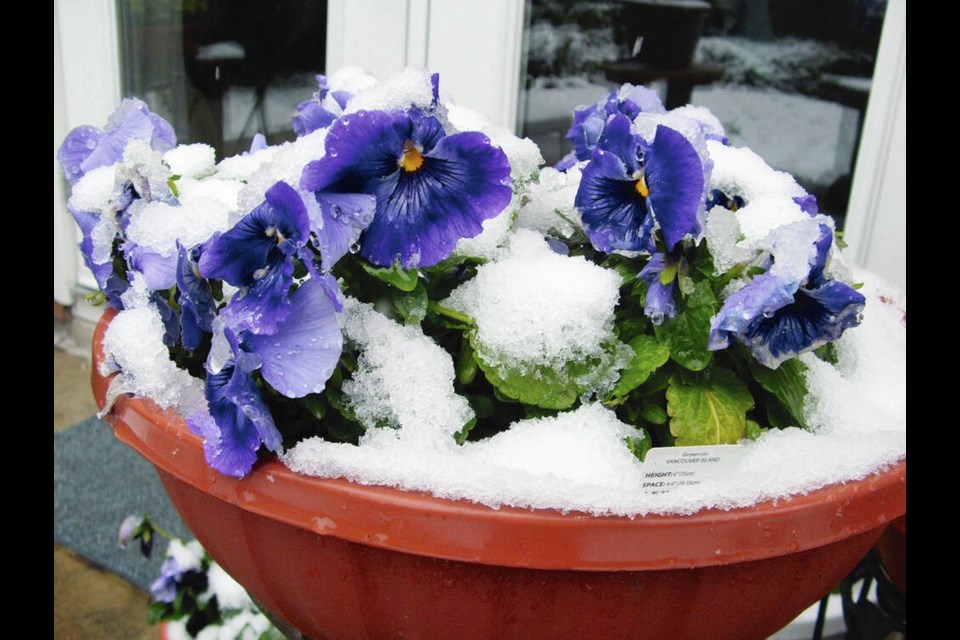So early in the year and already we’re well set up for another wacky weather ride, roller coaster style.
Around a month ago temperatures dipped to -10 C and in some areas to -12 C as gardeners scurried ahead of the freeze-up to harvest some of the least cold-hardy vegetables and cover others in layers of leaves, straw, old blankets and tarps.
Two weeks later, the rains had returned along with temperatures of the same numbers but in above-freezing, early springtime territory. What next? Remember last year? In the last week of February I was shovelling 30 cm of snow from the driveway.
Gardeners will be hoping that El Nino will bless us with conditions evenly warm enough to usher in an early planting season.
Survival. Before the hard freezing weather, I retrieved potted pansies and violas from their stands on the patio and placed them up against house walls in a corner of the carport. Because of the warm weather through December and early January, the little plants were full of flowers.
Over the course of the freezing weather, the poor wee things shrank down to practically nothing and turned completely crispy. I held no hope they could rebound from being so completely frozen.
Then, as temperatures edged over freezing levels, they gradually returned to normal. The blooms were even fully intact, except for a few browned “freezer burn” edges. Another reason to treasure these tough little plants that require almost no care in return for flowers from early autumn through spring.
Concern over what I might find in the thawed-out vegetable plots caused some hesitation over venturing out to check. When I did, I did not find the utter devastation that I had expected.
The kale plants had maintained their sprightly leafage and the globe artichokes still sported tufts of soft young foliage. The leeks are fine, and a young cabbage head that I’d missed on my pre-freeze-up harvesting spree had remained in good shape.
There was even life in the two small salad vegetable plots that had been covered with two tarps over plastic tunnelling. Several small curly endive plants are fine, along with several miniature “Gem” type romaine lettuces.
Peace lily. On my most recent visit to a nearby garden centre I was looking for a few specific seed varieties, but was waylaid by a splendid surprise — a table filled with pots housing a plant I’d long been hoping to acquire.
Beautiful “peace lily” (Spathiphyllum) plants were growing in 10-cm wide pots, ideal for my windowsill collection of tropicals.
It has been years since I’d had a peace lily in the house, but I’ve always admired the plant for its glossy, bright green leaves that flare out gracefully from the plant’s centre — giving it another common name: Sail plant.
Spathiphyllum is named for the leaf-like spathe (a large bract) that encloses the spike-like flower. “Peace lily” is for the white spathe (commonly thought of as the flower) resembling white flags of peace.
As I do with all new house plants, I isolated it at the glass patio door for a week before placing it with other plants, to make sure it was not harbouring undesirable hitchhikers.
GARDEN EVENTS
Peninsula meeting. The Peninsula Garden Club will meet on Monday, Feb. 12, at 7 p.m. in the Mary Winspear Centre in Sidney. Barrie Agar will speak about “Growing Fruit Trees and Berries that can be Cultivated in Small Spaces and Containers” Barrie was the head gardener at Royal Roads University for nearly twenty years. He is currently president of the Cowichan Valley Rhododendron Society and head of the BC Fruit Testers Association. The evening includes a parlour show and advice from Master Gardeners. Guest admission fee $5.
Dinter Nursery demonstrations. Dinter Nursery, 2205 Phipps Rd. in Duncan, is presenting the following demonstrations. Both are free of charge. No registration is required.
• Starting seeds. Sunday, Feb. 11, 11 a.m. to 12 p.m. Beth from West Coast Seeds will explain and demonstrate seeding basics: selecting flower and vegetable seeds, needed supplies, seed sowing techniques, when to start different seeds, handling seedlings, and preparing for planting outdoors. This demonstration will take place in a heated greenhouse.
• Rose Pruning. Saturday, Feb. 17, 10 to 11 a.m. Nat, Dinter’s resident landscape horticulturist, will show participants how to prune their roses. This demonstration will take place outdoors or in an unheated greenhouse. Please dress warmly.



